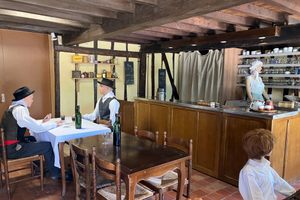Der Lake (or Lac du Der-Chantecoq) is the largest artificial lake in metropolitan France in terms of surface area. Built in the early 1970s, it was designed to protect Paris from flooding by regulating the flow of the Marne River. But in its wake, three villages were engulfed by water. Today, visitors can explore the few vestiges of these towns that disappeared beneath the water at the Der Lake Museum Village.
Following decades of planning, an extensive system of diversion channels was constructed to supply water to and from the lake. During the wetter months, water from the Marne is diverted into Der Lake, where it is stored before being released back into the river during the drier summer period. Dikes were erected to contain it, submerging the woodland, farms, and villages of Chantecoq, Champaubert-aux-Bois, and Nuisement-aux-Bois.
Approximately 300 villagers had to be relocated, along with several buildings, to the nearby commune of Sainte-Marie-du-Lac-Nuisement. There, a “museum village” was established to preserve the memory of the area that disappeared overnight. Visitors can see the town hall and school from Nuisement-aux-Bois, along with the 14th- to 15th-century church and its cemetery, a barn, the blacksmith’s house, and a dovecote.
The museum also displays historical documents and newspaper clippings recounting the creation of the lake, along with a looping video featuring archival footage and interviews with displaced residents. A small-scale model depicts what the villages once looked like, and items recovered from farms, workshops, and restaurants are on display, with mannequins adding to the frozen-in-time mystique of the visit. The bar-restaurant, for example, appears much as it would have in the 1950s and ’60s.
Meanwhile, spanning 48 square kilometers, the lake has developed into a popular tourist destination, with campsites and beaches dotted around its perimeter. It is also a haven for birds, with several hides available for birdwatchers to observe them year-round.
